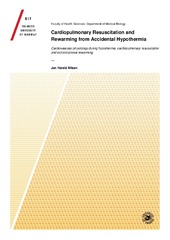| dc.contributor.advisor | Tveita, Torkjel | |
| dc.contributor.author | Nilsen, Jan Harald | |
| dc.date.accessioned | 2022-02-24T09:31:58Z | |
| dc.date.available | 2022-02-24T09:31:58Z | |
| dc.date.issued | 2022-03-11 | |
| dc.description.abstract | This thesis springs from 3 different papers: Paper 1 A randomised controlled study in rats to investigate whether an infusion of crystalloids or colloids during rewarming from hypothermia could alleviate the alterations in cardiovascular function seen in untreated control animals. Paper 2 A randomised controlled study in pigs, examining normothermic vs hypothermic cardiopulmonary resuscitation (CPR). Our central hypothesis was that the cardiac output (CO) generated by CPR would not be affected by hypothermia, thereby replacing a larger portion of native CO at a reduced temperature. This, in turn, would provide sufficient oxygen delivery to sustain aerobic metabolism in organs during 3 hours of CPR at 27°C. Paper 3 The effects of extracorporeal membrane oxygenation (ECMO) rewarming to restore oxygen delivery and organ blood flow were explored. Pigs were cooled to 27°C, underwent 3 hours of hypothermic CPR and subsequent rewarming by ECMO. Main results and conclusions Volume substitution improved hemodynamic function during rewarming from hypothermia and mitigated post-hypothermic cardiac dysfunction. We saw a sustained hemodynamic effect in rats treated with dextran vs crystalloid solution. The treated animals displayed reduced levels of intracellular calcium (Ca<sup>2+</sup>) in cardiac tissue compared to controls. Maintaining euvolemia with intravenous fluids during rewarming from hypothermia diminished the cardiac dysfunction seen in untreated controls. CO and mean arterial pressure (MAP) generated by CPR were not affected by hypothermia. Three hours of continuous resuscitation at 27°C provided limited but sufficient oxygen delivery to allow aerobic metabolism. In contrast, the normothermic animals displayed deteriorated hemodynamic function and significantly reduced organ blood flow after 45 minutes of CPR. These findings encourage early and continuous CPR in victims of accidental hypothermia. Rewarming pigs by ECMO after 3 hours of CPR at 27°C restored CO, MAP, the oxygen extraction ratios (O2ER), and blood flow to heart, left temporal lobe, cerebellum, stomach and small intestine. After ECMO rewarming, the favourable prognostic markers of survival after cardiac arrest were present in all animals: moderately increased lactate levels, return of pH to physiologic levels, and a shockable heart rhythm. These factors may be attributed to the protective effects of hypothermia during prolonged CPR, but they also support the critical role of ECMO in rewarming victims of accidental hypothermia. | en_US |
| dc.description.doctoraltype | ph.d. | en_US |
| dc.description.popularabstract | There are numerous accounts of successful rewarming of hypothermia victims with cardiac arrest. Reports from northern Norway include rewarming from a core temperature as low as 13,7°C and resuscitation times before rewarming could start exceeding 6 hours. When researching a topic with very few patients, we must seek alternatives.
We cooled rats to 15°C and treated them with two different intravenous fluids during rewarming. We found that keeping a normal blood volume during rewarming had a positive effect on the heart failure seen during rewarming from hypothermia compared to untreated animals.
We cooled pigs to 27°C and induced cardiac arrest. We established an automated CPR device, resuscitated them for 3 hours and then rewarmed them by extracorporeal circulation. We found that oxygen delivery during 3 hours of CPR was marginal but probably sufficient to sustain aerobic metabolism. Blood flow during CPR was preferred to critical organs (heart and brain). Extracorporeal rewarming re-established blood flow to critical organs. | en_US |
| dc.description.sponsorship | Stiftelsen Norsk Luftambulanse | en_US |
| dc.identifier.uri | https://hdl.handle.net/10037/24126 | |
| dc.language.iso | eng | en_US |
| dc.publisher | UiT The Arctic University of Norway | en_US |
| dc.publisher | UiT Norges arktiske universitet | en_US |
| dc.relation.haspart | <p>Paper 1: Nilsen, J.H., Schanche, T., Kondratiev, T.V., Hevrøy, O., Sieck, G.C. & Tveita, T. (2021). Maintaining intravenous volume mitigates hypothermia‐induced myocardial dysfunction and accumulation of intracellular Ca<sup>2+</sup>. <i>Experimental Physiology, 106</i>(5), 1196-1207. Also available in Munin at <a href=https://hdl.handle.net/10037/23442>https://hdl.handle.net/10037/23442</a>.
<p>Paper 2: Nilsen, J.H., Valkov, S., Mohyuddin, R., Schanche, T., Kondratiev, T.V., Naesheim, T., Sieck, G.C. & Tveita, T. (2020). Study of the Effects of 3 h of Continuous Cardiopulmonary Resuscitation at 27°C on Global Oxygen Transport and Organ Blood Flow. <i>Frontiers in Physiology, 11</i>, 213. Also available in Munin at <a href=https://hdl.handle.net/10037/18567>https://hdl.handle.net/10037/18567</a>.
<p>Paper 3: Nilsen, J.H., Schanche, T.L., Valkov, S., Mohyuddin, R., Håheim, B., Kondratyev, T., Næsheim, T., Sieck, G.C. & Tveita, T. Effects of Rewarming with Extracorporeal Membrane Oxygenation to Restore Oxygen Transport and Organ Blood Flow After Hypothermic Cardiac Arrest in a Porcine Model. (Manuscript accepted for publication). Now published in <i>Scientific Reports, 11</i>, 18918, 2021, available in Munin at <a href=https://hdl.handle.net/10037/23160>https://hdl.handle.net/10037/23160</a>. | en_US |
| dc.rights.accessRights | openAccess | en_US |
| dc.rights.holder | Copyright 2022 The Author(s) | |
| dc.rights.uri | https://creativecommons.org/licenses/by-nc-sa/4.0 | en_US |
| dc.rights | Attribution-NonCommercial-ShareAlike 4.0 International (CC BY-NC-SA 4.0) | en_US |
| dc.subject | VDP::Medisinske Fag: 700::Klinisk medisinske fag: 750::Anestesiologi: 765 | en_US |
| dc.subject | VDP::Medical disciplines: 700::Clinical medical disciplines: 750::Anesthesiology: 765 | en_US |
| dc.title | Cardiopulmonary Resuscitation and Rewarming from Accidental Hypothermia | en_US |
| dc.type | Doctoral thesis | en_US |
| dc.type | Doktorgradsavhandling | en_US |


 English
English norsk
norsk
